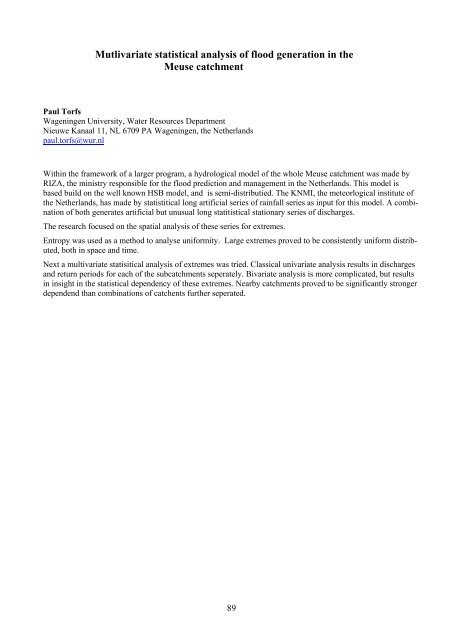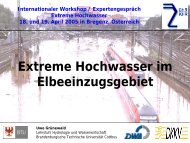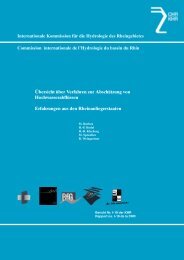ABSTRACTS 'Extreme Discharges' - CHR-KHR
ABSTRACTS 'Extreme Discharges' - CHR-KHR
ABSTRACTS 'Extreme Discharges' - CHR-KHR
You also want an ePaper? Increase the reach of your titles
YUMPU automatically turns print PDFs into web optimized ePapers that Google loves.
Mutlivariate statistical analysis of flood generation in the<br />
Meuse catchment<br />
Paul Torfs<br />
Wageningen University, Water Resources Department<br />
Nieuwe Kanaal 11, NL 6709 PA Wageningen, the Netherlands<br />
paul.torfs@wur.nl<br />
Within the framework of a larger program, a hydrological model of the whole Meuse catchment was made by<br />
RIZA, the ministry responsible for the flood prediction and management in the Netherlands. This model is<br />
based build on the well known HSB model, and is semi-distributied. The KNMI, the meteorlogical institute of<br />
the Netherlands, has made by statistitical long artificial series of rainfall series as input for this model. A combination<br />
of both generates artificial but unusual long statitistical stationary series of discharges.<br />
The research focused on the spatial analysis of these series for extremes.<br />
Entropy was used as a method to analyse uniformity. Large extremes proved to be consistently uniform distributed,<br />
both in space and time.<br />
Next a multivariate statisitical analysis of extremes was tried. Classical univariate analysis results in discharges<br />
and return periods for each of the subcatchments seperately. Bivariate analysis is more complicated, but results<br />
in insight in the statistical dependency of these extremes. Nearby catchments proved to be significantly stronger<br />
dependend than combinations of catchents further seperated.<br />
89





